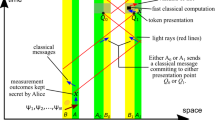Abstract
The use of quantum mechanical systems, such as polarized photons, to record information gives rise to novel cryptographic phenomena, not achievable with classical recording media: 1) A Verify Only Memory (VOM) that, with high probability, cannot be read or copied by someone ignorant of its contents; 2) the multiplexing of two messages in such a way that, with high probability, either message may be recovered at the cost of irreversibly destroying the other.
Quantum multiplexing can be combined with public-key cryptography to produce unforgeable subway tokens that resist counterfeiting even by an opponent with a supply of good tokens and complete knowledge of the turnstiles that test them.
Access this chapter
Tax calculation will be finalised at checkout
Purchases are for personal use only
Preview
Unable to display preview. Download preview PDF.
Similar content being viewed by others
References
W. Diffie and M.E. Hellman, New Directions in Cryptography, IEEE Trans. Info. Th., IT-22: 644 (1976).
R.L. Rivest, A. Shamir and L. Adleman, On Digital Signatures and Public-Key Cryptosystems, CACM, 21: 120 (1978).
G.B. Kolata, New Codes Coming into Use, Science Magazine 208: 694 (1980).
P.A.M. Dirac, “The Principles of Quantum Mechanics, 4th edition,” Oxford University Press (1958).
G. Brassard, Computationally Secure Authentication Tags Requiring Short Secret Shared Keys, in: “Advances in Cryptography: Proceedings of CRYPTO 82,” R. Rivest, ed., Plenum Press, New York (1983).
M. Blum, Coin Flipping by telephone: A Protocol for Solving Impossible Problems, in: “Proceedings of 24th Compcon,” IEEE, New York (1982).
M.O. Rabin, Digitalized Signatures and Public-Key Functions as Intractable as Factorization, MIT/LCS/TR-212 (1979).
D. Chaum, personal communication (1982).
Author information
Authors and Affiliations
Editor information
Editors and Affiliations
Rights and permissions
Copyright information
© 1983 Springer Science+Business Media New York
About this paper
Cite this paper
Bennett, C.H., Brassard, G., Breidbart, S., Wiesner, S. (1983). Quantum Cryptography, or Unforgeable Subway Tokens. In: Chaum, D., Rivest, R.L., Sherman, A.T. (eds) Advances in Cryptology. Springer, Boston, MA. https://doi.org/10.1007/978-1-4757-0602-4_26
Download citation
DOI: https://doi.org/10.1007/978-1-4757-0602-4_26
Publisher Name: Springer, Boston, MA
Print ISBN: 978-1-4757-0604-8
Online ISBN: 978-1-4757-0602-4
eBook Packages: Springer Book Archive




